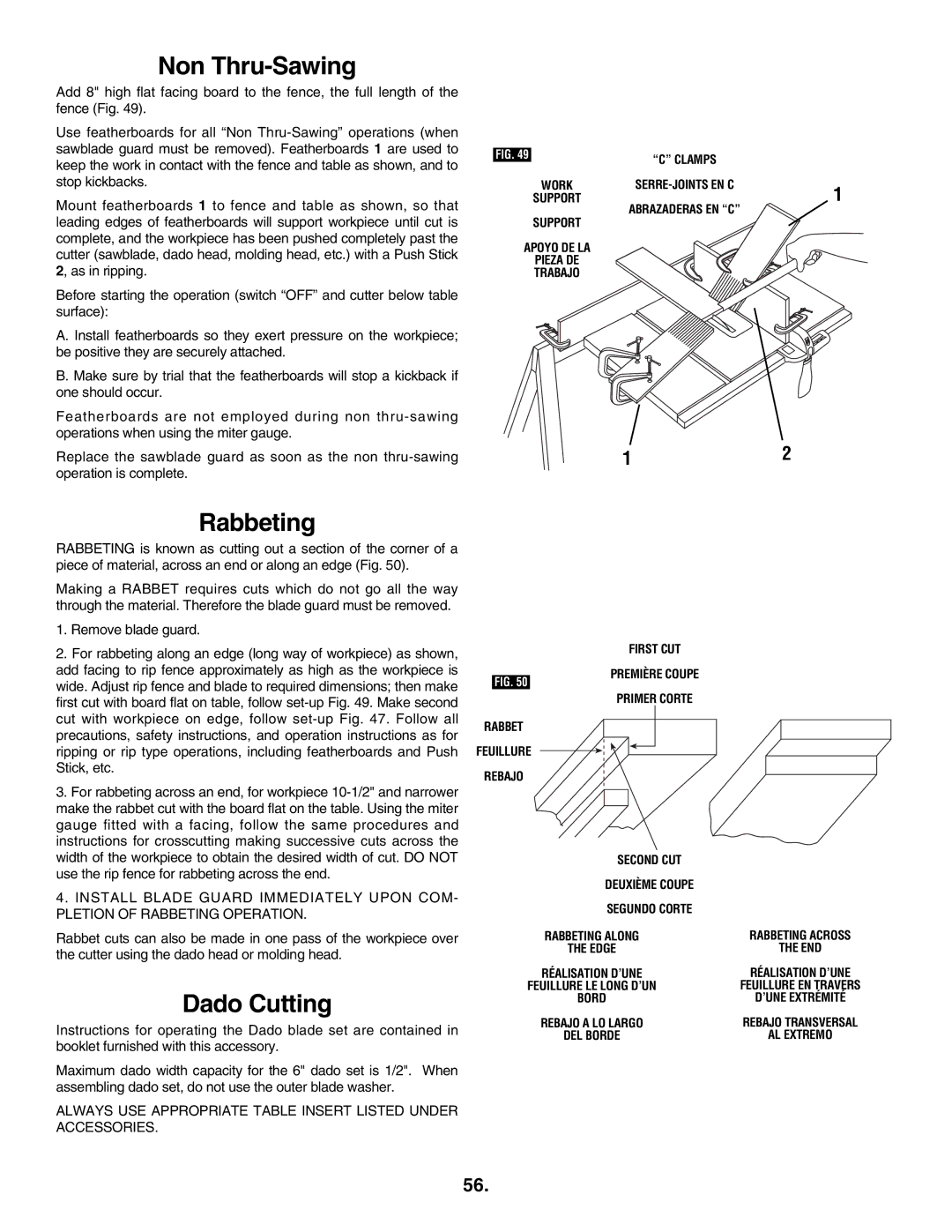
Non Thru-Sawing
Add 8" high flat facing board to the fence, the full length of the fence (Fig. 49).
Use featherboards for all “Non
Mount featherboards 1 to fence and table as shown, so that leading edges of featherboards will support workpiece until cut is complete, and the workpiece has been pushed completely past the cutter (sawblade, dado head, molding head, etc.) with a Push Stick 2, as in ripping.
Before starting the operation (switch “OFF” and cutter below table surface):
A. Install featherboards so they exert pressure on the workpiece; be positive they are securely attached.
B. Make sure by trial that the featherboards will stop a kickback if one should occur.
Featherboards are not employed during non
Replace the sawblade guard as soon as the non
FIG. 49 |
| “C” CLAMPS |
|
|
|
| |
| WORK | 1 | |
| SUPPORT |
|
ABRAZADERAS EN “C”
SUPPORT
APOYO DE LA
PIEZA DE
TRABAJO
12
Rabbeting
RABBETING is known as cutting out a section of the corner of a piece of material, across an end or along an edge (Fig. 50).
Making a RABBET requires cuts which do not go all the way through the material. Therefore the blade guard must be removed.
1. Remove blade guard. |
2. For rabbeting along an edge (long way of workpiece) as shown, |
add facing to rip fence approximately as high as the workpiece is |
wide. Adjust rip fence and blade to required dimensions; then make |
first cut with board flat on table, follow |
cut with workpiece on edge, follow |
precautions, safety instructions, and operation instructions as for |
FIG. 50
RABBET
FIRST CUT
PREMIÈRE COUPE
PRIMER CORTE
ripping or rip type operations, including featherboards and Push |
Stick, etc. |
3. For rabbeting across an end, for workpiece |
make the rabbet cut with the board flat on the table. Using the miter |
gauge fitted with a facing, follow the same procedures and |
instructions for crosscutting making successive cuts across the |
width of the workpiece to obtain the desired width of cut. DO NOT |
use the rip fence for rabbeting across the end. |
4. INSTALL BLADE GUARD IMMEDIATELY UPON COM- |
PLETION OF RABBETING OPERATION. |
Rabbet cuts can also be made in one pass of the workpiece over the cutter using the dado head or molding head.
Dado Cutting
Instructions for operating the Dado blade set are contained in booklet furnished with this accessory.
Maximum dado width capacity for the 6" dado set is 1/2". When assembling dado set, do not use the outer blade washer.
ALWAYS USE APPROPRIATE TABLE INSERT LISTED UNDER ACCESSORIES.
FEUILLURE
REBAJO
SECOND CUT
DEUXIÈME COUPE
SEGUNDO CORTE
RABBETING ALONG
THE EDGE
RÉALISATION D’UNE
FEUILLURE LE LONG D’UN
BORD
REBAJO A LO LARGO
DEL BORDE
RABBETING ACROSS
THE END
RÉALISATION D’UNE
FEUILLURE EN TRAVERS
D’UNE EXTRÉMITÉ
REBAJO TRANSVERSAL
AL EXTREMO
56.
